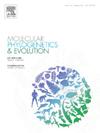The big, the small and the weird: A phylogenomic analysis of extant Priapulida
IF 3.6
1区 生物学
Q2 BIOCHEMISTRY & MOLECULAR BIOLOGY
引用次数: 0
Abstract
Priapulida is a small phylum of 22 described species that are divided into two size classes (microscopic and macroscopic), distinguished by adult and larval morphology. Most priapulidans are rare or live in inaccessible habitats, and freshly collected material for molecular studies is difficult to obtain. With this study, we for the first time aim to resolve the phylogeny of extant Priapulida using transcriptomic, genomic, and morphological data. We analyze six newly assembled transcriptomes alongside existing data, covering seven species and four genera. Additionally, we include genomic data from museum-preserved species, adding another genus via low-coverage genome sequencing. Conserved regions from these data produce a combined phylogenomic tree, augmented by morphological data to suggest positions for the rare taxa Acanthopriapulus and Maccabeus. Our findings show that the microscopic Meiopriapulus consistently groups as a sister taxon to other priapulidans and not with Tubiluchus, as suggested in previous studies. Maccabeus, which exhibits both size-class characteristics, is the sister taxon to all the macroscopic species, while Acanthopriapulus is a sister taxon to Priapulus, but molecular data are needed to support their suggested positions. Ancestral state reconstruction suggests that small body size, lack of caudal appendages, and internal fertilization are ancestral traits for Priapulida. This supports the derived evolution of macroscopic size and other traits in the group, aligning with its microscopic sister groups Kinorhyncha and Loricifera. Due to the diversity of priapulidans and the unique morphologies of some species, further fossil studies and potential discoveries of priapulidan microfossils are essential to fully understand the evolutionary history of this phylum.

求助全文
约1分钟内获得全文
求助全文
来源期刊
CiteScore
7.50
自引率
7.30%
发文量
249
审稿时长
7.5 months
期刊介绍:
Molecular Phylogenetics and Evolution is dedicated to bringing Darwin''s dream within grasp - to "have fairly true genealogical trees of each great kingdom of Nature." The journal provides a forum for molecular studies that advance our understanding of phylogeny and evolution, further the development of phylogenetically more accurate taxonomic classifications, and ultimately bring a unified classification for all the ramifying lines of life. Phylogeographic studies will be considered for publication if they offer EXCEPTIONAL theoretical or empirical advances.

 求助内容:
求助内容: 应助结果提醒方式:
应助结果提醒方式:


